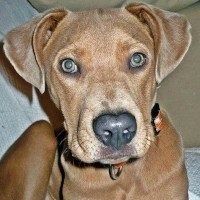Appearance of the Boweimar
|
| The Boweimar is a large breed, with males weighing up to 36 kilos and reaching heights of almost 1 meter. They have short coats and are usually black with white spots or markings, but can be brown. Your pet is likely to share many of the characteristics of the parent breeds, and may vary according to which breed is more dominant. Their muzzle is longer than that of a Boxer, generally resembling the Braque de Weimar side. They are fairly tall and slender, and their feet may be webbed. As for eye color, they are generally brown after the Boxer side rather than the gray, blue or amber eyes of a Braque de Weimar. |
Temperament of the Boweimar
|
| The Boweimar is an energetic, friendly dog that would make an excellent pet. They are likely to take on the traits of parent breeds, so will need plenty of exercise to keep them on their best behavior. They can suffer from separation anxiety, so it will be best to take your pet to training while it's still a puppy so it can learn socialization skills and get used to others. Boweimars can be quite demanding for attention and have been known to bark excessively if they don't get enough. Training will also help with this and they are considered sensitive to instruction. They prefer not to spend too much time alone and can become destructive if left to their own devices. They are considered good with children and are playful and friendly, but can be wary of strangers. The breed is quite protective of its family and makes good watchdogs. |
Needs and activities of the Boweimar
|
| The best way to keep the breed fit and well behaved is to take them for regular walks and to the dog park. Boweimars are intelligent dogs and would respond well to games of chase and run using a Frisbee or ball. This could be done in an enclosed yard or on the beach as long as the dog was under vocal control. Most breeds, including the Boweimar, will be more active when younger, but it's important not to overexert young puppies to avoid damaging the still-growing bones. It's best not to exercise your dog in extreme weather conditions, and with its short coat, it has a fairly low tolerance to the cold. |
Maintenance of the Boweimar
|
| With a Boweimar's coat so short, it won't require much grooming, so brushing once a week should be sufficient. These are not hypoallergenic dogs, and they don't shed much. Because of their short coat, they're also unlikely to need bathing unless absolutely necessary. But brushing is always good to keep the skin stimulated and to check for ticks or other parasites. Keep their ears clean to avoid any infection, which can be caused by wiping the inside of the ear with damp absorbent cotton. Check eyes regularly for any changes or discharge, as the breed is prone to eye problems. Nails should be trimmed as needed and teeth brushed regularly to maintain good health. |









 English (United Kingdom)
English (United Kingdom)